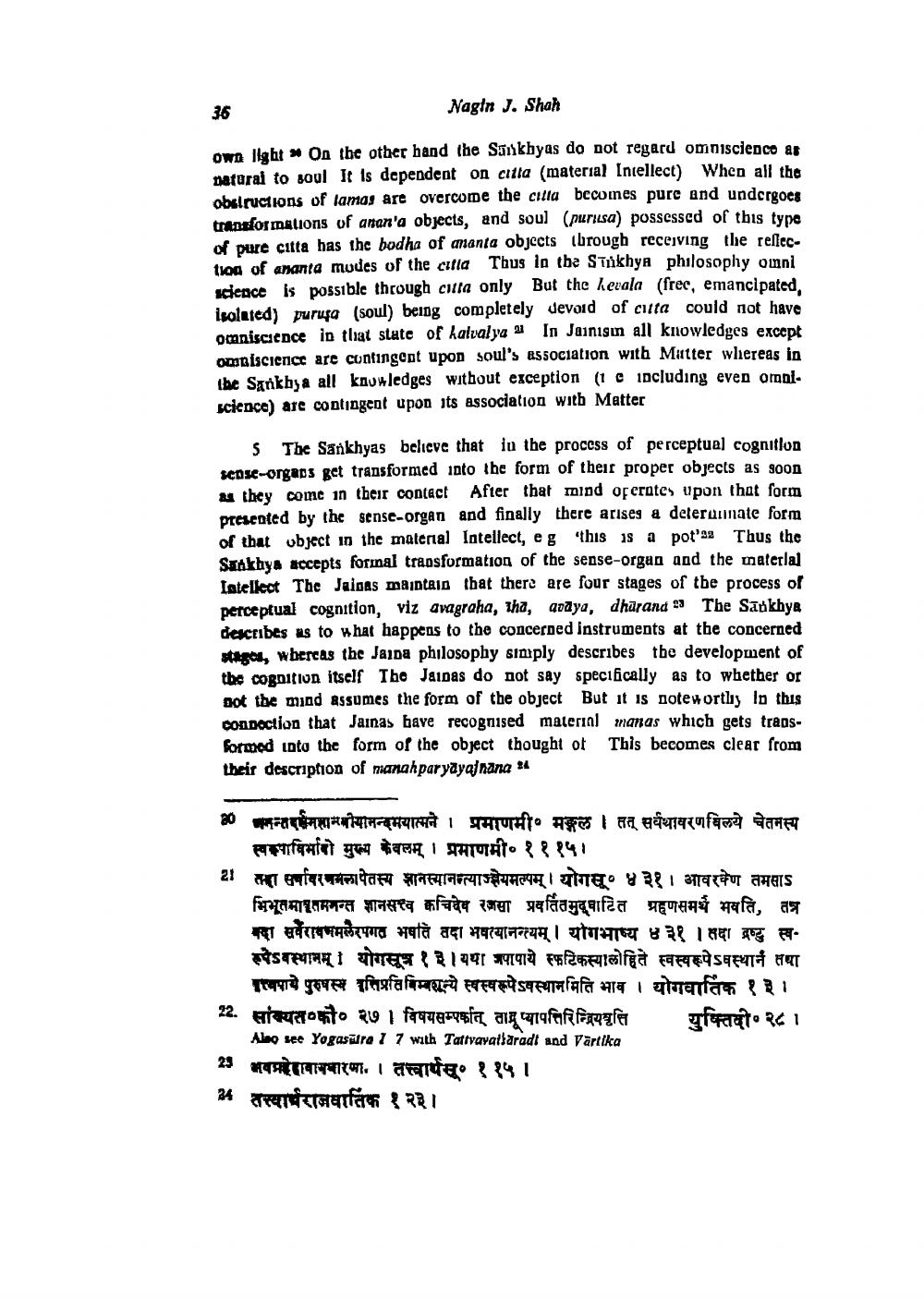________________
36
Nagin J. Shah
own light on the other hand the Sukhyas do not regard omniscienco as natural to soul It is dependent on citla (material Intellect) When all the obstructions of lamas are overcome the citia becomes pure and undergoes transformations of anan'a objects, and soul (purusa) possessed of this type of pure citta has the bodha of ananta objects through receiving the rellection of ananta modes of the citla Thus in the Sinkhya philosophy omni science is possible through citta only But the hevala (free, emancipated. isolated) purusa (soul) being completely devoid of cuta could not have omniscience in that state of halval ya 2 In Jainisin all knowledges except omniscience are contingent upon soul's Association with Mutter whereas in the Sankhya all knowledges without exception (1 e including even omniscience) are contingent upon its association with Matter
S The Sankhyas believe that in the process of perceptual cognition sense-orgaps get transformed into the form of their proper objects as soon as they come in their contact After that mind operates upon that form presented by the sense-organ and finally there arises a determinate form of that object in the material Intellect, eg this is a potas Thus the Sankhya accepts formal transformation of the sense-orgun and the material Intellect The Jainas maintain that there are four stages of the process of perceptual cognition, viz avagraha, tha, avdya, dharand el The Sankhya describes as to what happens to the concerned instruments at the concerned stago, whereas the Jaina philosophy sinıply describes the development of the cognition itself The Jaidas do not say specifically as to whether or not the mind assumes the form of the object But it is notewortly in this condoction that Jainas have recognised material manas which gets transformed into the form of the object thought of This becomes clear from their description of manah paryaya nana 24
20 अनन्तवमलाम्बीयानन्दमयात्मने । प्रमाणमी. मङ्गल । तत् सर्वथावरणविलये चेतमस्य
स्वमावि को मुख्य केवलम् । प्रमाणमी०१११५। तथा सर्वावरणमलापेतस्य शानस्यानम्त्याज्ञयमल्पम् । योगसू० ४३१ । आवरण तमसाs भिभूतमातमनन्त ज्ञानसत्त्व क्वचिदेव रजसा प्रवर्तितमुद्घाटित ग्रहणसमर्थ भवति, तत्र बदा सर्वेरावममलेरपगत भषति तदा भवत्यानन्त्यम् । योगभाष्य ४३१ । सदा द्रष्टु स्वरूपेऽवस्थामम् । योगसूत्र १३॥ यथा अपापाये स्फटिकस्यालोहिते स्वस्वरूपेऽवस्थान तथा
त्वपाये पुरुषस्य बत्तिप्रतिविम्बशून्ये स्वस्वरूपेऽवस्थाममिति भाव । योगवार्तिक १३ । 22. सांक्यतःकौ० २७ । विषयसम्पर्कात् तादू प्यापत्तिरिन्द्रियवृत्ति युक्तिवी. २८ ।
Also see Yogasüra 1 7 with Tattvavatsaradt and Vārtika 23 भवनोहावापधारमा । तत्त्वार्यसू० ११५ ।
तस्वाराजवातिक १२३।




